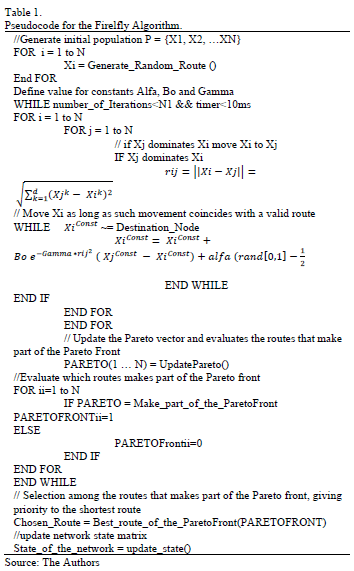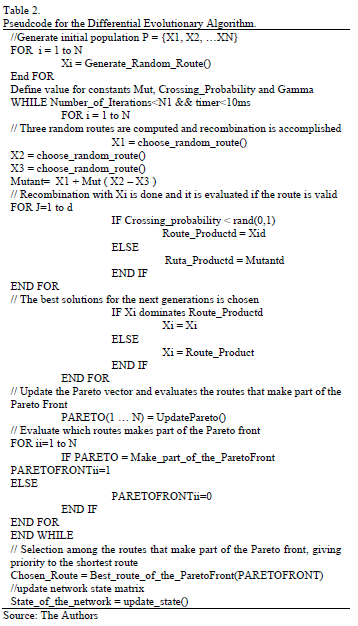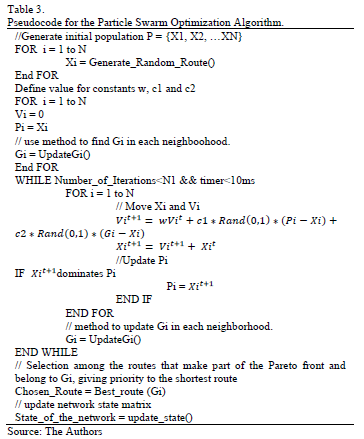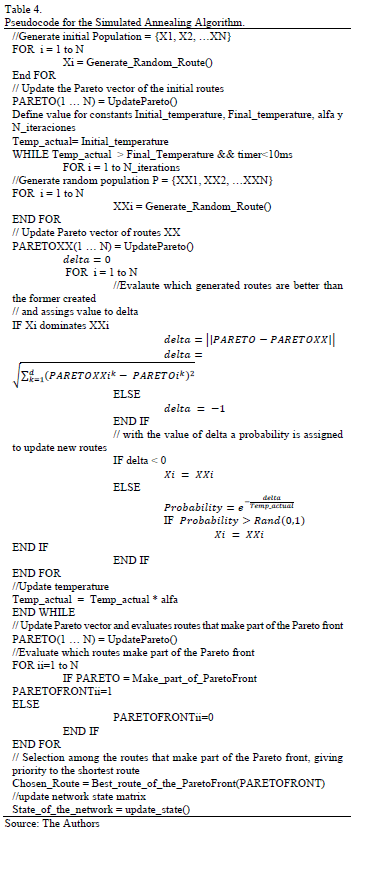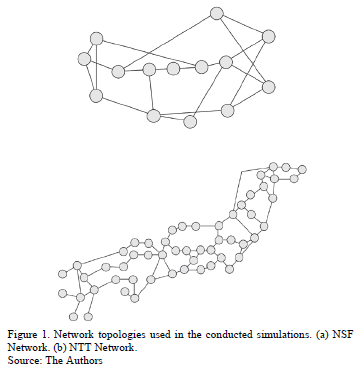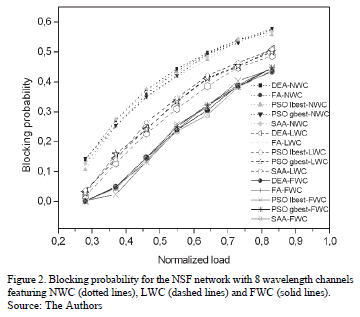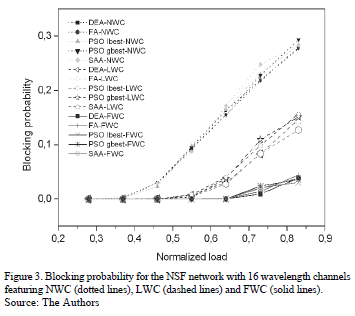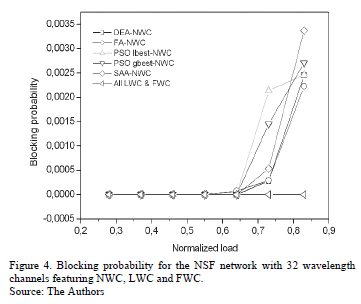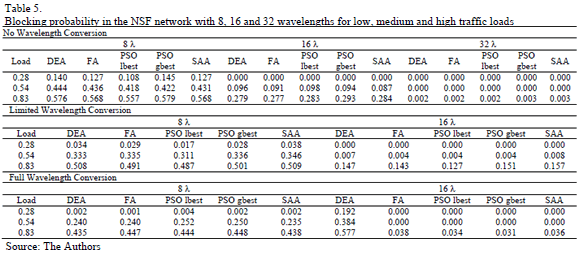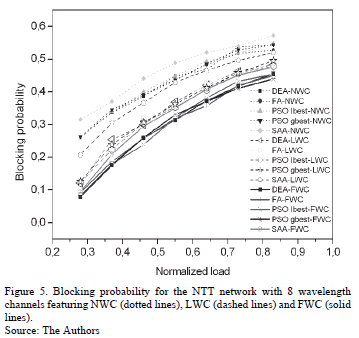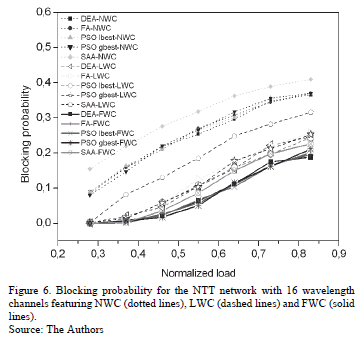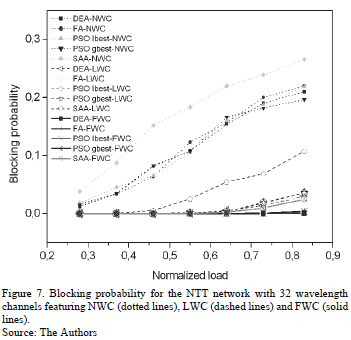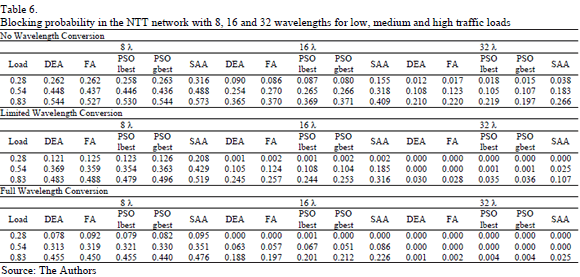Serviços Personalizados
Journal
Artigo
Indicadores
-
 Citado por SciELO
Citado por SciELO -
 Acessos
Acessos
Links relacionados
-
 Citado por Google
Citado por Google -
 Similares em
SciELO
Similares em
SciELO -
 Similares em Google
Similares em Google
Compartilhar
DYNA
versão impressa ISSN 0012-7353
Dyna rev.fac.nac.minas vol.82 no.194 Medellín nov./dez. 2015
https://doi.org/10.15446/dyna.v82n194.49663
DOI: http://dx.doi.org/10.15446/dyna.v82n194.49663
A comparative study of multiobjective computational intelligence algorithms to find the solution to the RWA problem in WDM networks
Estudio comparativo de algoritmos de inteligencia computacional multiobjetivo para la solución del problema RWA en redes WDM
Bryan Montes-Castañeda a, Jorge Leonardo Patiño-Garzón b & Gustavo Adolfo Puerto-Leguizamón c
a Facultad de Ingeniería, Universidad Distrital Francisco José de Caldas, Bogotá, Colombia, bmontesc@correo.udistrital.edu.co
b Facultad de Ingeniería, Universidad Distrital Francisco José de Caldas, Bogotá, Colombia, jlpatinog@correo.udistrital.edu.co
c Facultad de Ingeniería, Universidad Distrital Francisco José de Caldas, Bogotá, Colombia, gapuerto@udistrital.edu.co
Received: March 16th, 2015. Received in revised form: May 27th, 2015. Accepted: June 11th, 2015.
This work is licensed under a Creative Commons Attribution-NonCommercial-NoDerivatives 4.0 International License.
Abstract
This paper presents a comparative study of multiobjective algorithms to solve the routing and wavelength assignment problem in optical networks. The study evaluates five computational intelligence algorithms, namely: the Firefly Algorithm, the Differential Evolutionary Algorithm, the Simulated Annealing Algorithm and two versions of the Particle Swarm Optimization algorithm. Each algorithm is assessed based on the performance provided by two different network topologies under different data traffic loads and with a different number of wavelengths available in the network. The impact of implementing wavelength conversion processes is also taken into account in this study. Simulated results show that, in general, the evaluated algorithms appropriately solve the problem in small-sized networks in which a similar performance was found. However, key differences were found when the size of the network is significant. This means that more suitable algorithms optimize the search space and the fall into local minimums is avoided.
Keywords: multiobjective algorithms; optical networks; heuristic algorithms; RWA problem.
Resumen
Este artículo presenta un estudio comparativo de algoritmos multiobjetivo para la solución del problema de enrutamiento y asignación de longitudes de onda en redes ópticas. El estudio evalúa cinco algoritmos de inteligencia computacional, a saber: el algoritmo de luciérnaga, el algoritmo evolutivo diferencial, el algoritmo de enfriamiento simulado y dos versiones del algoritmo de optimización por enjambre de partículas. Cada algoritmo se evaluó teniendo en cuenta las prestaciones obtenidas sobre dos topologías de red con diferentes cargas de tráfico y diferente número de longitudes de onda disponibles. El impacto de incorporar procesos de conversión de longitud de onda también se tuvo en cuenta en este estudio. Los resultados de simulación muestran que los algoritmos estudiados resuelven apropiadamente el problema en redes con pocos nodos. Sin embargo, diferencias puntuales se encontraron en redes con un número significativo de nodos, lo cual hace más apropiados a los algoritmos que optimicen el espacio de búsqueda y eviten caer en mínimos locales.
Palabras clave: algoritmos multiobjetivo; algoritmos heurísticos; problema RWA; redes ópticas.
1. Introduction
Optical fiber has been consolidated as the preferred means of transmission in today's high-speed and long reach data networks. There have been several reasons for this situation, firstly, the increasing growth of data traffic consumption, which is expected to continue in the forthcoming years [1]. Secondly, the optical fiber systems have reached technological maturity and so they allow optical networks to be deployed, which are capable of managing huge amounts of bandwidth while providing more functions than just point-to-point transmission. These kinds of networks are known as wavelength-routing networks; their related advantages are based on some switching and routing functions that are performed in the optical domain. These were previously performed in the network by electronics. A wavelength-routed network provides lightpaths to its clients i.e. optical connections carried end-to-end from a source node to a destination node using a wavelength on each intermediate link. Depending on the node capabilities, in some cases the lightpaths may be converted from one wavelength to another wavelength, allowing each optical channel to be spatially reused in different parts of the network. The key aspect of designing a wavelength-routing network is in the process that determines the wavelength or set of wavelengths that must be provided on each link that minimize the probability of network blocking from a given number of requests. This aspect is known as the wavelength-dimensioning problem or Routing and Wavelength Assignment (RWA) problem when the lightpath routing process is involved in the general solution of the problem.
In this context, two versions of the RWA problem can be considered. The first is called the offline RWA problem in which all the lightpaths are given at once. The solution to this form of the problem is mainly useful during network planning stages. However, when the network is operational the online RWA is a better answer, as the problem has to be solved for each lightpath at a time.
Solving this issue is not trivial. According to the computational complexity theory, the RWA problem is considered to be NP-complete; this means that it cannot be solved within a polynomial time (the required time to solve any problem by means of deterministic algorithms). For this reason, traditional methods using deterministic algorithms might not be good alternatives to solve the RWA problem. Some nondeterministic algorithms may offer acceptable results: heuristic algorithms represent an alternate solution despite their iterative behavior.
Different approaches from different perspectives have been proposed to solve the RWA problem. A first approach was based on Integer Linear Programming (ILP) in which the routing and wavelength assignment were treated separately. A description of the routing techniques using ILP is presented in [2,3] and the methods for routing and wavelength assignation are widely discussed in [4-10]. Nevertheless, for large networks with broad traffic to transport, the ILP solutions have shown some drawbacks, more precisely the potential assignation of a number of lightpaths to a given node higher than the number of wavelengths available in the network; something that brings about network blocking. Heuristic algorithms have shown to be more efficient in solving the RWA problem than the ILP approaches; in fact, one of the most used heuristics is the Tabu search [11]. Another heuristic method widely used is Genetic Algorithms (GA). Taking this into consideration, a comparative study between the GA and the Simulated Annealing (SA) concluded that GA produced better results. Different proposals have also been found in the literature to optimize the RWA problem. One of these is based on Ant Colony (ACO) algorithms, which have been used to solve both static RWA and dynamic RWA [12,13]. In this context, an ant-based agents approach that reduces the blocking probability to 0.33 and features a traffic load of 60 Erlangs and 8 wavelengths is presented in [14].
This paper focuses on evaluating the solution to the online RWA problem using multiobjective theory [15]. The reason for using such a paradigm is due to the necessity to solve more than one objective and it aims at finding routes that better adapt to the online requests and reduce the blocking probability when the network is operational. The targeted objectives defined in this work are summarized as follows:
- Shortest number of hops: This is the problem's main objective. The shorter the number of lightpaths the fewer the network resources used.
- Low number of wavelength converters: Reducing the number of wavelength converters results in both cost-effective networks while improving the Signal to Noise Ratio (SNR).
- Average number of available wavelengths along the path: This aims at assuring that the algorithm evenly uses all the nodes in the network, avoiding the overload of specific nodes.
- Shortest physical path: This aims at reducing the cumulative delays of the lightpath.
In order to assess the multiobjective optimization algorithms, an initial solution to the RWA problem that consists of 30 random paths, the objective of which is to produce a significant amount of potential solutions in order to generate the Pareto front, is carried out. The algorithm to set up the initial paths is based on the work described in [16], [17]. In this paper, the evaluation of five algorithms based on multiobjective computational intelligence used to solve the RWA problem is presented. The performance of the Firefly Algorithm (FA) [18], the Differential Evolutionary Algorithm (DEA) [19], the Simulated Annealing Algorithm (SAA) [20] and two modifications of the Particle Swarm Optimization (PSO) algorithm [21-24] will be evaluated by varying the number of available wavelengths in the network and the amount of nodes featuring wavelength conversion in two different network topologies.
2. Multiobjective optimization algorithms
This section presents the multiobjective computational intelligence algorithms that were considered in the comparative study, namely: FA, DEA, SAA and PSO.
2.1. Firefly Algorithm (FA)
The firefly algorithm is based on the behavior and characteristics of the fireflies. A firefly uses a luminescent flash pattern to attract other fireflies. The higher the luminescence the firefly exposes, the stronger the attraction. The algorithm modifies the initial worst solutions (the worst paths in our context) to bring them closer to the individuals that perform a better solution i.e. individuals belonging to the Pareto front. Table 1 shows the pseudocode used for modeling the FA approach.
2.2. Differential Evolutionary Algorithm (DEA)
The genetic algorithms have been widely used to solve the RWA problem due to their relative ease in being implemented. In this work we propose a modification of the second-generation evolutionary algorithm called the Differential Evolutionary Algorithm [25]. The proposed adaptation aims at finding solutions following a multiobjective based operation in order to improve the performance of the solutions for the online version of the RWA problem. DEA is a modification of the traditional evolutionary algorithm that keeps a population of candidate solutions. Then, recombination and mutation procedures applied to these solutions produce new individuals to be chosen according to a performance function. In this work the initial population corresponds to the random lightpaths that generate the Pareto front, i.e. the performance function. The mutant population is generated by randomly taking groups of three individuals following the well-known Rand/1/bin variant [25,26]. From these recombined individuals, only those who represent valid lightpaths within the network are chosen. The generation of a new population is accomplished by comparing each recombined individual and the parent population; those individuals who dominate (parent or recombined individual) are chosen to be part of the Pareto front. This procedure guarantees that every new population generated is better than the previous one. The pseudocode defined for the DEA is shown in Table 2.
2.3. Particle Swarm Optimization (PSO)
The PSO algorithm is based on the behavior of bees when they look for areas with a significant amount of pollen [21]. Each particle (bee) carries out a search and memorizes the best location they found, i.e. they remember the best solution they have discovered. In addition, each particle commits to memory the best solution provided by k amount of informers that they are connected to. The model is called lbest for low values of k and gbest for values of k as high as the swarm size. Both models were evaluated in this work, k=5 was used in the context of lbest (low number of particles with the basic amount of informers to carry out an efficient search), whereas k=30 was used to model gbest (each particle has as informers the remaining particles). Also, in the context of the proposed multiobjective algorithm, Vi is the velocity of the particle Xi, Pi is the best solution found by Xi and Gi is the best solution found by the swarm. The pseudocode to model the PSO algorithm is shown in Table 3.
2.1. Simulated Annealing Algorithm (SAA)The simulated annealing algorithm is inspired by the annealing process of steel and ceramics in which the physical properties of the material is modified through heating (atoms increase its energy) and there is a subsequent controlled slow cooling processes (higher probabilities to re-crystallize in configurations featuring a lower energy than that featured at the beginning of the process). This procedure leads to a slow decrease in the probability of accepting worse solutions as it explores the solution space. For the sake of proposing an approach that follows multiobjective theory, random solutions are used instead of neighbor solutions. These solutions will be constantly compared with the initial results in order to expand the search space during the cooling process.
The SAA works on every one of the 30 initial lightpaths, i.e. each lightpath is compared with 30 different paths that are generated in the same way as the initial solution at every moment during the cooling process. If a solution generated in a given iteration is better than the initial, then the lightpath is updated, otherwise a probability is assigned for the particular lightpath to be chosen. The pseudocode for SAA is shown in Table 4.
3. Topology and traffic characteristics
In order to evaluate the proposed optimization algorithms, the conducted simulations were performed based on the topology characteristics of the National Science Foundation Network (NSFNet). This consists of 14 nodes and 42 optical links and the Nippon Telegraph and Telephone Network (NTT) that is comprised of 55 nodes and 144 links [27]. The significant differences in the number of nodes and links allow a more comprehensive understanding of the capabilities and performances of the evaluated algorithms. Fig. 1 shows the topology of the two networks considered in this work.
The evaluation of the algorithms is based on the normalized traffic load that is present in the networks. The normalized load in Erlangs is given by:

Where T is the average time during which a given lightpath is active in the network, N is the initial number of nodes that generate traffic and ltotal is the average number of requests per unit of time that depends on the average number of requests from the initial node n (ln) as follows:

In the context of this work, the online traffic is defined following a Poisson distribution such as that seen in [13,18,28,29]. Thus, the probability that k requests per unit time generated using ln is:

Once the number of requests per unit of time is chosen, the destination nodes are selected following a uniform distribution. Each request must state the amount of time for which it will be active. In this work an exponential distribution with a mean T of 50 seconds was used.

Where T is defined by:

4. Experimental results
Once the network topology and the data traffic are defined, the modeled algorithms are contrasted based on the capacity of the network to perform wavelength conversion. With this feature, a lightpath may be set up in such a way that several wavelengths are used along the path, which, in turn, provides flexibility to the network as the probability to set up such a lightpath is increased. The simulations conducted involved configurations in both network topologies featuring Full Wavelength Conversion (FWC), Limited Wavelength Conversion (LWC) and No Wavelength Conversion (NWC). FWC implies that all the nodes in the network have the capability to perform wavelength conversion while in LWC only some nodes have such capacity. NWC means that wavelength conversion processes are not performed in the network. The number of wavelengths available in the network was 8, 16 and 32 respectively, with traffic loads ranging from 0.28 to 0.83. The availability of optical channels is examined for the FWC, LWC and NWC configurations in the NSF Network. Performance results for the evaluated algorithms are shown in Fig. 2, 3, and 4 respectively. Fig. 2 shows the blocking probability as a function of the normalized load for the 8 wavelengths available on the network. Note that at high traffic loads, NWC leads to roughly 57% of blocking probability, whereas FWC derives approximately 42%. Overall, for 8 wavelength channels, the blocking probability is improved by 15% when the load is high (>0.8), 20% for medium traffic loads (0.5) and 13% for lost traffic loads (<0.3). As can be seen, the highest improvement is obtained in the medium zone, i.e. when the channel operates at half of its capacity. Low traffic loads lead to few inputs for the algorithms to find the best solution while the high traffic demand featured at high loads does not allow the algorithms to find an appropriate solution within the short time interval of each request. As far as the behavior of the evaluated algorithms is concerned, negligible differences between them were found in the FWC configuration. For NWC and LWC, the DEA and SAA respectively had a lower performance in comparison with the remaining algorithms.
When the networks incorporate 16 wavelengths, the blocking performance is improved, as can be seen in Fig. 3. Note that at high traffic load for NWC, the blocking probability is reduced to 28% (this is 29% less than the value obtained with 8 wavelengths).
It was also found that for medium to low traffic loads, the blocking probability is very low (less than 5%), while for medium to high loads the LWC and FWC configurations led to blocking probabilities that were lower than 12%. These had negligible differences between the evaluated algorithms in FWC. In this context, despite minimum differences in the obtained results, the algorithm that derived the lower performance was the SAA, while the best performance was Table 5 summarizes the blocking probability featured by the algorithms studied in low, medium and high traffic loads under NWC, LWC and FWC schemes with 8, 16 and 32 wavelengths.
As mentioned above, the algorithms were also evaluated in the topology characteristics of the NTT network. In order to give a comparative framework, the evaluation undertaken followed the same procedures and configuration that was accomplished in the NSF network. Fig. 5 shows the results for 8 wavelengths. Note that the fact of having more nodes and more links makes the NWC, LWC and FWC results more uniform, resulting in a rough average difference of 10% between the NWC and FWC configurations. Note that SAA presents a significantly different performance compared with the other algorithms, mainly for the NWC and LWC. It should be pointed out that for the LWC configuration, SAA has a similar performance to the FA in the NWC configuration. This fact demonstrates that SAA needs more network resources to offer functionalities similar to the remaining algorithms when the size of the network is significant. Also, note that blocking events appear for low traffic loads. This is caused by a low number of resources (wavelength channels) available in the moment of setting up the lightpaths. The blocking probability when the network uses 16 wavelengths is shown in Fig. 6. With this arrangement, the low performance of SAA in NWC, LWC and FWC configurations is more noticeable. Also, the blocking probability for a low traffic load falls to zero and the FWC leads to uniform behavior of the evaluated algorithms. A reduction of 17% for the blocking probability at high traffic loads (>0.8) in comparison to the NWC performance results was found.
This comparative study, a significant number of wavelength resources in networks with a substantial number of nodes and links are shown in Fig. 7. Primarily, negligible differences were found in the LWC and FWC for all the evaluated algorithms except SAA. This showed the lowest performance, being up to an 8% less efficient for LWC configuration, PSO lbest is consistent and had a good performance. The blocking probability is, in general, reduced to values lower than 4% for LWC at high traffic load and nearly to zero for FWC configuration. Besides SAA, all the algorithms present no blocking from medium to low traffic loads in both LWC and FWC.
In order to make the outcomes clearer, Table 6 summarizes the blocking probability featured by the studied algorithms in low, medium and high traffic loads under NWC, LWC and FWC schemes with 8, 16 and 32 wavelengths.
5. Conclusions
Five heuristic algorithms based on multiobjective optimization were described and evaluated in this paper. The algorithms allow the problem of wavelength and routing assignment in optical networks to be solved from a dynamic behavior perspective. Each one of the evaluated algorithms offered positive results f to minimize, for example, the distance between nodes, number of hopes and availability of wavelength channels. These were taken into account simultaneously in order to provide a closer approximation to the operation of a real network. The algorithms were evaluated based on the traffic load presented in the network, thus, normalized loads from 0.28 to 0.83 were set up by changing the mean time duration of each lightpath. In general, the multiobjective nature of the evaluated algorithms appropriately solved the RWA problem, and similar results were found in all cases. However, the best results were given by the PSO lbest as each one of the six swarms used in the configuration carry out searches all over the optimization space. This fact avoided that the potential routes that could be chosen were not blocked or held back in a local minimum.
The available number of wavelengths, along with the capability of wavelength conversion, is an important feature to be implemented in optical networks. This feature allows the significant reduction of network blocking by reusing optical channels all along the end-to-end path. The wavelength conversion process allows the network control and management subsystem of the optical networks to be more adaptive to traffic changes while supporting better high data traffic loads.
Acknowledgement
The authors wish to acknowledge the Universidad Distrital Francisco José de Caldas for supporting the development of this paper.
References
[1] CISCO. Cisco Visual Networking Index: Global Mobile Data Traffic Forecast Update, 2013-2018, [Online]. White Paper, 2014, pp. 1-40. Available at: http://www.cisco.com/c/en/us/solutions/collateral/ service-provider/visual-networking-index-vni/white_paper_c11-520862.pdf [ Links ]
[2] Guitart, F., Algoritmos de routing en redes totalmente opticas, [Online]. 2012. [Date of reference March 01th of 2015]. Available at: http://www.it.uc3m.es/muruenya/rba2/trabajos2009/Algoritmos_Routing_Redes_Totalmente_Opticas.pdf [ Links ]
[3] Vinolee, R. and Bhaskar, V., Performance analysis of mixed integer linear programming with wavelength division multiplexing, 2nd International Conference onDevices, Circuits and Systems (ICDCS), pp.1-6, 2014. DOI: 10.1109/ICDCSyst.2014.6926153. [ Links ]
[4] Le, D.D., Fen, Z. and Molnar, M., Minimizing blocking probability for the multicast routing and wavelength assignment problem in WDM networks: Exact solutions and heuristic algorithms, IEEE/OSA Journal of Optical Communications and Networking, 7(1), pp. 36-48, 2015. DOI: 10.1364/JOCN.7.000036 [ Links ]
[5] Coiro, A., Listanti, M. and Matera, F., Energy-efficient routing and wavelength assignment in translucent optical networks, IEEE/OSA Journal of Optical Communications and Networking, 6(10), pp. 843-857, 2014. DOI: 10.1364/JOCN.6.000843 [ Links ]
[6] Manousakis, K., Angeletou, A. and Varvarigos, E., Energy efficient RWA strategies for WDM optical networks, IEEE/OSA Journal of Optical Communications and Networking, 5(4), pp. 338-348, 2013. DOI: 10.1364/JOCN.5.000338 [ Links ]
[7] Pavarangkoon, P. and Oki, E., A routing and wavelength assignment scheme supporting multiple light-source nodes in optical carrier-distributed networks, 4th IEEE International Conference onNetwork Infrastructure and Digital Content (IC-NIDC), pp. 168-173, 2014. DOI: 10.1109/ICNIDC.2014.7000287 [ Links ]
[8] Balasis, F., Xin, W., Sugang, X. and Tanaka, Y., Dynamic physical impairment-aware routing and wavelength assignment in 10/40/100 Gbps mixed line rate optical networks, 16th International Conference on Advanced Communication Technology (ICACT), pp. 343-351, 2014. DOI: 10.1109/ICACT.2014.6779192 [ Links ]
[9] Bandyopadhyay, A., Sarkar, A., Bhattacharya, U. and Chatterjee, M., Improved algorithms for dynamic routing and wavelength assignment in WDM all-optical mesh networks, Eleventh International Conference on Wireless and Optical Communications Networks (WOCN), pp. 1-5, 2014. DOI: 10.1109/WOCN.2014.6923050 [ Links ]
[10] Sakthivel, P. and Sankar, P.K., Dynamic multi-path RWA algorithm for WDM based optical networks, International Conference on Electronics and Communication Systems (ICECS), pp. 1-5, 2014. DOI: 10.1109/ECS.2014.6892807 [ Links ]
[11] Charbonneau, N. and Vokkarane, V.M., Tabu search meta-heuristic for static manycast routing and wavelength assignment over wavelength-routed optical WDM networks, IEEE International Conference on Communications (ICC), pp. 1-5, 2010. DOI: 10.1109/ICC.2010.5502241 [ Links ]
[12] Al-Momin, M., Cosmas, J. and Amin, S., Enhanced ACO based RWA on WDM optical networks using requests accumulation and re-sorting method, Computer Science and Electronic Engineering Conference (CEEC), pp. 97-102, 2013. DOI: 10.1109/CEEC.2013.6659453 [ Links ]
[13] Shen, J. and Cheng, X., An improved ant colony based algorithm for dynamic routing and wavelength assignment scheme in optical networks, The 2nd International Conference on Computer Application and System Modeling, [Online]. 2012. [Date of reference March 01th of 2015]. Available at: http://www.atlantis-press.com/php/download_paper.php?id=2481. [ Links ]
[14] Ngo, S., Jiang, X., Horiguchi, S. and Guo, M., Dynamic routing and wavelength assignment in WDM networks with ant-based agents, Springer Berlin Heidelberg, [Online]. 3207, pp 829-838, 2004. [Date of reference March 01rd of 2015]. Available at: http://link.springer.com/chapter/10.1007%2F978-3-540-30121-9_79#page-1 [ Links ]
[15] Coello, C., Lamont, G. and Van, D., Evolutionary algorithms for solving multi-objective problems, [Online]. Springer Science+Business Media, LLC, 2007. [Date of reference March 01 rd of 2015]. Available at: http://www.inf.ufpr.br/aurora/disciplinas/topicosia2/livros/Evolutionary%20Algorithms%20For%20Solving%20Multi-Objective%20Problems%202Nd%20Edition.pdf [ Links ]
[16] Cui, Y., Xu, K., Wu, J. and Yu, Z., Multi-constrained routing based on simulated annealing, ICC '03, IEEE International Conference, 3, pp 1798-1722, 2003. DOI: 10.1109/ICC.2003.1203894 [ Links ]
[17] Hai-Bo, M., Jian-Ning, Y. and Lin-Zhong, L., Shortest path algorithm for road network with traffic restriction, 2009 2nd International Conference, Power Electronics and Intelligent Transportation System (PEITS), 2, pp 381-384, 2009. DOI: 10.1109/PEITS.2009.5406759 [ Links ]
[18] Rubio-Largo, A., Vega-Rodriguez, M.A., Gomez-Pulido, J.A. and Sanchez-Pérez, J.M., A Comparative study on multiobjective swarm intelligence for the routing and wavelength assignment problem, IEEE Transactions, Systems, Man, and Cybernetics, Part C: Applications and Reviews, 42(6), pp 1644-1655, 2012. DOI: 10.1109/TSMCC.2012.2212704 [ Links ]
[19] Rubio-Largo, A., Vega-Rodríguez, M.A., Gómez-Pulido, J.A. and Sánchez-Pérez, J.M., A differential evolution with Pareto tournaments for solving the routing and wavelength assignment problem in WDM networks, IEEE Congress on Evolutionary Computation (CEC), pp. 1-8, 2010. DOI: 10.1109/CEC.2010.5586272 [ Links ]
[20] Hernández, J., Hernández, S. y Flores, I., Algoritmo recocido simulado para el problema de la programación del tamaño del lote económico bajo el enfoque de ciclo básico, Revista chilena de ingeniería, [Online], 19(3), pp 473-485, 2011. [Date of reference March 01rd of 2015]. Available at: http://www.scielo.cl/pdf/ingeniare/v19n3/art15.pdf [ Links ]
[21] Bhushan, B. and Pillai, S., Particle swarm optimization and firefly algorithm: Performance analysis, 2013 IEEE 3rd International, Advance Computing Conference (IACC), pp 746-751, 2013. DOI: 10.1109/IAdCC.2013.6514320 [ Links ]
[22] Amaya, I., Gómez, L. and Correa, R., Discrete particle swarm optimization in the numerical solution of a system of linear diophantine equations, DYNA, 81(185), pp. 139-144, 2014. DOI: 10.15446/dyna.v81n185.37244 [ Links ]
[23] Bermeo, L.A., Caicedo, E., Clementi, L. andVega, J., Estimation of the particle size distribution of colloids from multiangle dynamic light scattering measurements with particle swarm optimization, Ingeniería e Investigación, 35(1), pp. 49-54. DOI: 10.15446/ing.investig.v35n1.45213 [ Links ]
[24] Muñoz, M., López, J. y Caicedo, E., Inteligencia de enjambres: Sociedades para la solución de problemas (Una revisión), Ingeniería e Investigación, 28(2), pp. 119-130. [ Links ]
[25] Li, Y.-L., Zhan, Z.-H., Gong, Y.-J., Chen, W.-N., Zhang, J. and Li, Y., Differential evolution with an evolution path: A DEEP evolutionary algorithm, IEEE Transactions on Cybernetics, PP(99), pp. 1-13, 2014. DOI: 10.1109/TCYB.2014.2360752 [ Links ]
[26] Villate, A., Rincon, D.E. y Melgarejo, M.A., Sintonización de sistemas difusos utilizando evolución diferencial. IEEE XVIII International Congress of Electronic and Systems Engineering. Lima: 2011, pp. 1-8. [ Links ]
[27] Rubio, A. and Vega, M., Optical network topologies and data sets for the RWA Problem, [Online]. [Date of reference March 01rd of 2015]. Available at: http://mstar.unex.es/mstar_documentos/RWA/RWA-Instances.html [ Links ]
[28] Bisbal, D., Dynamic routing and wavelength assignment in optical networks by means of genetic algorithms, Photonic Network Communications, [Online]. 7(1), pp.43-58, 2004. [Date of reference March 01rd of 2015]. Available at: http://link.springer.com/article/10.1023/A%3A1027401202391#page-1 [ Links ]
[29] Hassan, A., Phillips, C. and Zhiyuan L., Swarm intelligence based Dynamic Routing and Wavelength Assignment for wavelength constrained all-optical networks, ISCIT 2009, 9th International Symposium, pp 987-992, 2009. DOI: 10.1109/ISCIT.2009.5340993 [ Links ]
B. Montes-Castañeda, received his BSc. in Electronic Engineering with an emphasis on Computational Intelligence, Telematics and Digital Signal Processing in 2015, from the Universidad Distrital Francisco José de Caldas, Colombia. In 2013 he joined the Microwave, Electromagnetism and Radiation Laboratory (LIMER) where he developed his undergraduate thesis. His research interests include telecommunications, optical networks and heuristic optimization. ORCID: 0000-0003-4333-445X.
J.L. Patiño-Garzón, received his BSc. in Electronic Engineering with emphasis on Computational Intelligence, Telecommunications and Digital Signal Processing in 2015, from the Universidad Distrital Francisco José de Caldas, Colombia. In 2013 he joined the Microwave, Electromagnetism and Radiation Laboratory (LIMER) where he developed his undergraduate thesis. His research interests include heuristic algorithms, low and high level programming languages and optical networks. ORCID: 0000-0002-8615-9447,
G.A. Puerto-Leguizamón, received his BSc. in Telecommunications Engineering in 2002. He joined the Institute of Telecommunications and Multimedia Applications at the Universitat Politècnica de València in Spain, where he completed his advanced research studies in 2005 and his PhD. in 2008. As a postdoctoral researcher he worked as co-leader of the task on the new generation of physical technologies for optical networks under the framework of the European funded project ALPHA (Architectures for Flexible Photonics Home and Access Networks). Since 2012 he has been an assistant professor at the Universidad Distrital Francisco José de Caldas in Bogotá, Colombia, where he works in the Microwave, Electromagnetism and Radiation Laboratory (LIMER). He has published more than 40 papers in journals and international conferences and he is a reviewer of the IEEE Journal on Lightwave Technologies and IEEE Photonic Technology Letters. His research interests include optical networking and radio over fiber systems. ORCID: 0000-0002-6420-9693.













